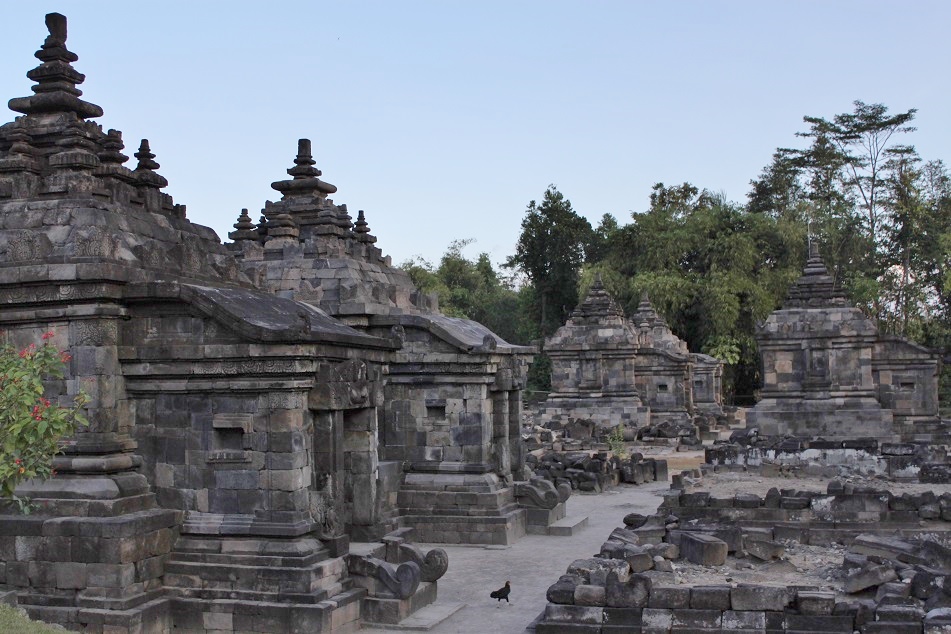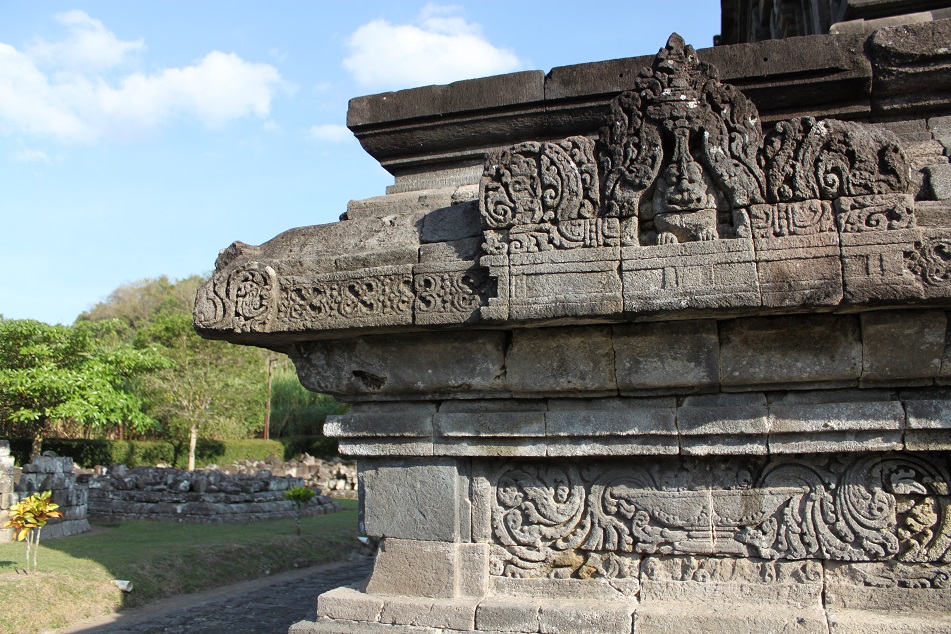Chapter 1, Part 10
Pramodhawardhani, the daughter of Samaratungga of the Buddhist Sailendra dynasty, as well as the wife of Rakai Pikatan, the new Hindu king of Medang, ruled the kingdom in a conciliatory period between the two religions in the mid-ninth century AD. During her husband’s reign, Prambanan was commissioned, while the queen consort herself became the patroness of Buddhism. Not only did she oversee the construction of new Buddhist temples, but she also exempted some villages in Kedu Plain from tax in return of the preservation of Bhumisambhara, a magnificent temple what we now call Borobudur.
About two kilometers from Shivagrha, an elegant Hindu temple his husband built to mark the return of Hinduism to the royal court of Medang, Pramodhawardhani commissioned the construction of a Buddhist temple compound, consisting of two main temples surrounded by smaller shrines, and another group of temples a few hundred meters to the south.
Plaosan Lor, as the northern group is called today, is an ensemble of two main temples with identical architectural style in a walled enclosure with hundreds of small stupas and shrines encircling the wall. The two main temples, albeit looking the same, are in fact adorned with different sculpted figures. The northern of the two have female characters carved on its outer walls, while the other have male characters. Both are adorned with reliefs of bodhisattvas.
Some people speculate this male-female distinction was in fact a symbol of Rakai Pikatan and Pramodhawardhani’s union. In other words, not only was the temple used for religious rituals, but they were built as a manifestation of love between the king and the queen consort, a true Javanese romantic monument. The architecture itself reflects a marriage of Hinduism and Buddhism, a portrayal of the contemporary political situation during its construction.
About six kilometers south of Plaosan, a small Buddhist temple sat in solitude, hugged by verdant hills with a view of rice paddies to the front. Little is known about the history of this temple, but it is believed that Candi Banyunibo, as how it is now known, was built in the ninth century, probably around the time when Rakai Pikatan ruled Medang.
A much smaller temple than Plaosan, Candi Banyunibo’s most distinctive feature is its curved rooftop, reminiscent of ijuk (black fibers) roofs found in Balinese and ancient Javanese vernacular architecture. Similar to other Central Javanese ancient temples, a set of Kala and Makara was added at the base of Candi Banyunibo’s entrance – a feature later disappeared in East Javanese temples.
Richly decorated with ornate reliefs, a panel depicting Hariti – the goddess of child protection and family happiness in the tradition of Mahayana Buddhism – can be found on the wall leading to the inner sanctum. The same character can also be found at another, and older, Buddhist temple called Venuvana (Candi Mendut).
Candi Banyunibo is a small, surviving temple from a period when harmony was of utmost importance in the kingdom of Medang, even more of a priority than expanding influence beyond its borders. Its story and philosophy, as well as those of other temples from the same period, is a reminder from the past for people today what it means to coexist in peace.
Click here for the full list of stories from the Spice Odyssey series.
















kak bama itu Bodhisattva in Tribhanga di candi mana? prambanan?
LikeLike
Di Plaosan. Kan post ini mengenai Plaosan dan Banyunibo. 🙂
LikeLike
This was a beautiful pictorial and an informative piece.
LikeLike
Thank you. Glad you enjoyed this post.
LikeLiked by 1 person
Banyunibo saya ingat sebagai candi yang asri sekali karena letaknya di tengah sawah :)). Kayaknya Jawa adalah lumbung yang sangat makmur di masa kejayaan candi-candi itu, Mas. Dataran Kewu itu memang kaya banget akan peninggalan masa klasik… bahkan bukan tidak mungkin masih banyak yang terpendam, menunggu untuk dikuak :)).
Suka dengan risetnya yang tajam dan lugas! Informasinya jadi sampai banget ke pembaca :)).
LikeLike
Waktu itu saya naik mobil dan sempat ragu begitu jalan mulai menyempit. Tapi memang tidak diperlukan jalan lebar sih sepertinya, toh pengunjungnya sangat sedikit, sebagaimana halnya dengan banyak candi lain di Dataran Kewu. Ada satu blog yang mendokumentasikan candi-candi yang telah ditemukan tapi belum direkonstruksi dengan baik, penanda bahwa memang sangat mungkin masih banyak candi yang masih terkubur di dalam tanah, menunggu cangkul seorang petani membuka tabirnya. Makasih Bli Gara. Semoga belum bosan baca cerita mengenai candi-candi Jawa di blog ini, hehe. Masih ada satu post lagi sebelum move on ke luar Jawa. 🙂
LikeLiked by 1 person
Pertama saya ke sana malah mesti menuntun motor karena badan jalan dipakai tempat menjemur gabah :haha. Tapi lumayanlah jadi bisa kenal dengan pak petani di sana :)).
Ah kalau soal candi Jawa, saya bisa meyakinkan kalau saya jarang bosan :hihi. Apalagi kalau ditulisnya jos apik tenan seperti ini. Tulisan selanjutnya ditunggu :)).
LikeLike
Haha, di kampung memang kendaraan mesti berbagi dengan komoditas. Pas saya ke Tidore sebagian badan jalan juga dipakai menjemur cengkeh.
Matur suksma. 🙂
LikeLiked by 1 person
Insanely beautiful photographs. Thanks for sharing and safe travels!
LikeLike
Hi Callie. Thanks for your kind words and for reading. Safe travels to you too, wherever the wind takes you.
LikeLike
Nice post, i just get a new knowledge about buddhist temples.
LikeLike
Thanks Bayu. Learning the history of those ancient Javanese temples is always interesting. Glad you enjoyed this post.
LikeLiked by 1 person
I can’t imagine the number of photos you must have to go through for these magnificent posts! The temples are so intricate and complex; I feel like I would have taken thousands of pictures to try to capture all the details. I always seem to love the places with Hindu and Buddhist combinations, and this is no exception!
LikeLike
436 photos from both temples, to be precise. 🙂 It’s not that many (compared to more than 3,000 photos I took in Bagan, Myanmar) because I had been to Plaosan before. Plaosan is one of my favorite ancient Javanese temples not only because of its intricacy and unique architecture, but also for its setting. You would love Plaosan, I believe.
LikeLiked by 1 person
I can see why Plaosan is one of your favourite ancient Javanese temples – its buildings are so rich with sculptures and I loved the secluded location amid the rice paddies. Banyunibo was a wonderful little jewel; the curved roof made the stone look so graceful and light. So many people only go to Borobudur and Prambanan then shoot off to Bromo or Bali. I’m so glad we had the time to visit these smaller, less-touristed temples.
LikeLike
And its architecture is quite different from other Buddhist temples in Kewu Plain. I was glad to know that Plaosan was still quiet and not touristy at all after my first visit in 2011. However we did miss one part of the temple compound: its northernmost mandapa. When we were at Banyunibo I secretly wished we had enough time to visit Candi Barong as well. But at least we still have a lot of temples to look for next time we go. 🙂
LikeLiked by 1 person
Stunning as always. It looks very peaceful there. And you were lucky enough to get some shots without other people in them! 🙂
LikeLike
Thanks! And you’re right, it really was not touristy at all. It was my second visit to the temple and it was very encouraging to see more parts of the temple compound had been reconstructed since my first visit. There were a few teenagers around, but most of the time my friends and I had the temples for ourselves.
LikeLiked by 1 person
That’s wonderful!
LikeLike
Wow, what beautiful photo’s! Thank you for sharing them, and the history and stories to go along with them.
LikeLike
Thank you for your kind words, and for dropping by my blog. Learning the history of ancient Javanese temples really broadens up my knowledge about the past connections among kingdoms in Southeast and South Asia, as well as events that changed the course of history in the region. Always fascinating.
LikeLike
So fascinating!
LikeLike
Bama I love the fact that a place such as this would be non touristy. That you would have time to explore quietly and reflectively. I smiled at the comment reply that you took 436 photos. Do you have a technique for sorting and deleting extras? I don’t take that many but the stock grows rampantly here.
As always I admire your research, your eloquent writing and of course your sensational images. A pleasure to visit and live vicariously through your posts.
LikeLike
And this temple is not too far from a far more touristy one, some 4 km away — It’s always nice to have ample time to go beyond the usual, jam-packed-with-people places. I wish I had a technique, but I honestly don’t. Sorting out photos is surely a time-consuming work, but more often than not it brings back some fond memories of my past trips. However on my latest trip across Southeast and South Asia I tried to not be too easy to press that shutter button and to be more selective with what kind of photos I wanted to shoot. Thanks for your lovely words, Sue, always.
LikeLike
masih kokoh banget ya kak candinya.. sya belum pernah berkunjung ke candi
mudah2n situs2 seperti bisa terjaga dg baik, kasihan anak cucu kalo ga bisa lihat bukti sejarah ini
LikeLike
Ini semua tidak terlepas dari rekonstruksi yang terus dilakukan oleh pihak terkait, meskipun prosesnya bisa sangat lama. Pertama kali saya ke Plaosan tahun 2011 masih banyak Candi Perwara yang teronggok, batuan penyusunnya hanya ditumpuk. Tapi pas saya ke sana lagi tahun kemarin sudah ada beberapa yang dibangun kembali seperti wujud aslinya. Mudah-mudahan situs-situs semacam ini dapat terjaga, dan yang bisa saya bantu adalah meningkatkan kesadaran sebanyak mungkin pihak mengenai pentingnya menjaga peninggalan purbakala yang kita miliki.
LikeLike
Pingback: The Fall of Constantinople | What an Amazing World!
Candi paling fotogenik dari semua candi yang kita kunjungi tahun kemarin Bam, menurutku lho ya. Terus ditambah dengan latar belakang kisah candinya dan juga perpaduan arsitekturnya yang merupakan percampuran antara gaya candi-candi Hindu dan Buddha.
Kayaknya paling pas memang berkunjung kesini pas senja ya.
LikeLike
Plaosan memang salah satu candi favoritku sih Bart. Ukurannya memang gak terlalu besar, tapi arsitektur dan layoutnya menurutku unik. Sayang pas kita ke sana kita gak ke mandapanya yang terletak di ujung utara kompleks percandian. Aku baru tau ada mandapa itu pas udah lama meninggalkan Jogja. 🙂
LikeLike